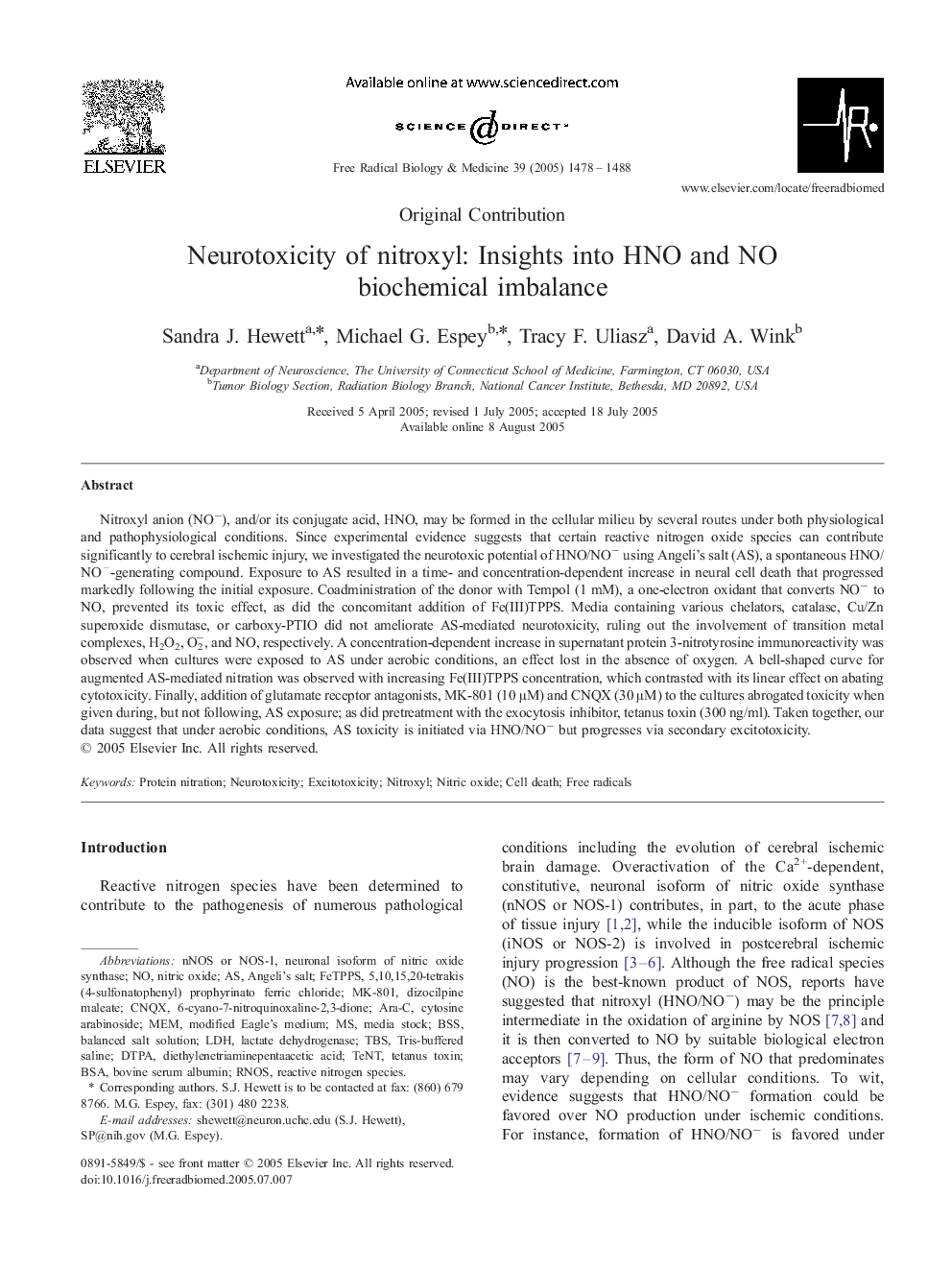| کد مقاله | کد نشریه | سال انتشار | مقاله انگلیسی | نسخه تمام متن |
|---|---|---|---|---|
| 10738841 | 1046836 | 2005 | 11 صفحه PDF | دانلود رایگان |
عنوان انگلیسی مقاله ISI
Neurotoxicity of nitroxyl: Insights into HNO and NO biochemical imbalance
دانلود مقاله + سفارش ترجمه
دانلود مقاله ISI انگلیسی
رایگان برای ایرانیان
کلمات کلیدی
DTPARNOSFeTPPSTeNTBSScytosine arabinosideTBSMK-8016-Cyano-7-nitroquinoxaline-2,3-dione - 6-Cyano-7-nitroquinoxaline-2،3-dioneBSA - BSAAra-C - آرا- Cbovine serum albumin - آلبومین سرم گاوexcitotoxicity - اکسید سمیتneuronal isoform of Nitric oxide synthase - ایزوفرم عصبی از سیتازاس اکسید نیتروژنTris-buffered saline - تریس بافر شورDiethylenetriaminepentaacetic acid - دی اتیلنتریمین پنتا اسیدهای اسیدDizocilpine maleate - دیئوسیلپین مایناتFree radicals - رادیکال آزادTetanus toxin - سموم تتراNeurotoxicity - سمیت عصبیCNQX - سیانکیوایکسlactate dehydrogenase - لاکتات دهیدروژناز LDH - لاکتات دهیدروژناز به صورت مختصر شده LDH MEM - مامانModified Eagle's Medium - متوسط اصلاح شده عقابbalanced salt solution - محلول نمک متعادلCell death - مرگ سلولی Angeli's salt - نمک آنجلیProtein nitration - نیترات پروتئینnitroxyl - نیتروکسیلNitric oxide - نیتریک اکسیدreactive nitrogen species - گونه های واکنش پذیر نیتروژن
موضوعات مرتبط
علوم زیستی و بیوفناوری
بیوشیمی، ژنتیک و زیست شناسی مولکولی
سالمندی
پیش نمایش صفحه اول مقاله

چکیده انگلیسی
Nitroxyl anion (NOâ), and/or its conjugate acid, HNO, may be formed in the cellular milieu by several routes under both physiological and pathophysiological conditions. Since experimental evidence suggests that certain reactive nitrogen oxide species can contribute significantly to cerebral ischemic injury, we investigated the neurotoxic potential of HNO/NOâ using Angeli's salt (AS), a spontaneous HNO/NOâ-generating compound. Exposure to AS resulted in a time- and concentration-dependent increase in neural cell death that progressed markedly following the initial exposure. Coadministration of the donor with Tempol (1 mM), a one-electron oxidant that converts NOâ to NO, prevented its toxic effect, as did the concomitant addition of Fe(III)TPPS. Media containing various chelators, catalase, Cu/Zn superoxide dismutase, or carboxy-PTIO did not ameliorate AS-mediated neurotoxicity, ruling out the involvement of transition metal complexes, H2O2, O2â, and NO, respectively. A concentration-dependent increase in supernatant protein 3-nitrotyrosine immunoreactivity was observed when cultures were exposed to AS under aerobic conditions, an effect lost in the absence of oxygen. A bell-shaped curve for augmented AS-mediated nitration was observed with increasing Fe(III)TPPS concentration, which contrasted with its linear effect on abating cytotoxicity. Finally, addition of glutamate receptor antagonists, MK-801 (10 μM) and CNQX (30 μM) to the cultures abrogated toxicity when given during, but not following, AS exposure; as did pretreatment with the exocytosis inhibitor, tetanus toxin (300 ng/ml). Taken together, our data suggest that under aerobic conditions, AS toxicity is initiated via HNO/NOâ but progresses via secondary excitotoxicity.
ناشر
Database: Elsevier - ScienceDirect (ساینس دایرکت)
Journal: Free Radical Biology and Medicine - Volume 39, Issue 11, 1 December 2005, Pages 1478-1488
Journal: Free Radical Biology and Medicine - Volume 39, Issue 11, 1 December 2005, Pages 1478-1488
نویسندگان
Sandra J. Hewett, Michael G. Espey, Tracy F. Uliasz, David A. Wink,